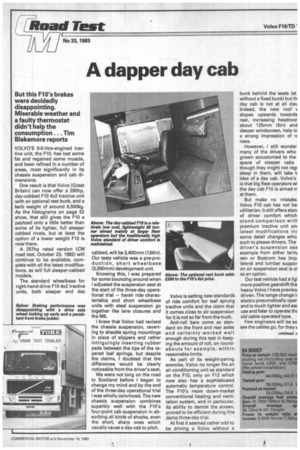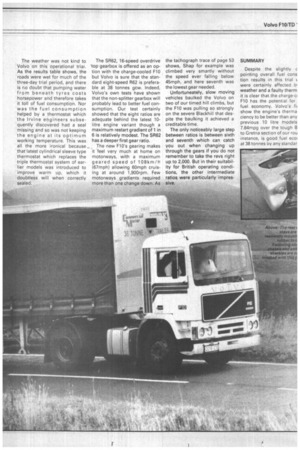A dapper day cab
Page 51

Page 52

Page 53

If you've noticed an error in this article please click here to report it so we can fix it.
But this FlO's brakes were decidedly disappointing.
Miserable weather and a faulty thermostat didn't help the consumption. . . Tim Blakemore reports
VOLVO'S 9.6-litre-engined tractive unit, the F10, has lost some fat and regained some muscle, and been refined in a number of areas, most significantly in its chassis suspension and cab dimensions.
One result is that Volvo (Great Britain) can now offer a 290hp, day-cabbed F10 4x2 tractive unit with an optional rest bunk, and a kerb weight of around 6,500kg. As the histograms on page 52 show, that still gives the F10 a payload only a little better than some of its lighter, full sleeper cabbed rivals, but at least the option of a lower weight F10 is now there.
A 257hp rated version (CM road test, October 23, 1982) will
continue to be available, complete with all the latest modifica
tions, as will full sleeper-cabbed models.
The standard wheelbase for right-hand-drive F10 4x2 tractive units, both sleeper and day cabbed, will be 3,400mm (134in). Our tests vehicle was a pre-prod u cti o n , short wheelbase (3,000mm) development unit.
Knowing this, I was prepared for some bouncing around when I adjusted the suspension seat at the start of the three-day operational trial — harsh ride characteristics and short wheelbase units with steel suspension go
together like lane closures and the M6.
knew that Volvo had revised the chassis suspension, reverting to shackle spring mountings in place of slippers and rather intriguingly inserting rubber pads between the tips of the ta pered leaf springs, but despite the claims, I doubted that the differences would be clearly noticeable from the driver's seat.
We were not long on the road to Scotland before I began to change my mind and by the end of the three-day operational trial I was wholly convinced. The new chassis suspension combines superbly well with the FlO's four-point cab suspension in absorbing all kinds of shocks, even the short, sharp ones which usually cause a day-cab to pitch. Volvo is setting new standards of ride comfort for leaf sprung tractive units and the claim that it comes close to air suspension for it is not so far from the truth.
Anti-roll bars come as standard on the front and rear axles and certainly worked well enough during this test in keeping the amount of roll, on roundabouts for example, within reasonable limits.
As part of its weight-paring exercise, Volvo no longer fits an air conditioning unit as standard on the F10, only on F12 which now also has a sophisticated automatic temperature control, The FlO's more down-market conventional heating and ventilation system, and in particular, its ability to demist the screen, proved to be efficient during this damp three-day trial.
At first it seemed rather odd to be driving a Volvo without a
bunk behind the seats (at without a fixed bunk) but th day cab is not at all clau Indeed, the new roof v slopes upwards towards rear, increasing headroor about 125mm (5in) and deeper windscreen, help to a strong impression of rc ness.
However, I still wonder many of the drivers who grown accustomed to the space of sleeper cabs though they might not regi sleep in them, will take ti idea of a day cab. Volvo's is that big fleet operators wi the day cab F10 is aimed rr at them.
But make no mistake, Volvo F10 cab has not be utilitarian. It still offers stem of driver comfort which stand comparison with premium tractive unit ant latest modifications inc some detail changes whic such to please drivers. The driver's suspension sea example from either Isrini sen or Bostrom has impi lateral and lumbar suppor an air suspension seat is ol as an option.
Our test vehicle had a ligl more positive gearshift tha heavy Volvo I have previou driven. The range change it electro pneumatically oper and is much lighter and ea; use and fater to operate thz old cable-operated type.
Few engineers will be so see the cables go, for they v • i frequently sieze or snap replacement components inordinately expensive. The a insulation between gear turret and cab aperture has beer improved with a Iger spring beneath the rubgaiter, so that now, as the cab rolls on curves, a gap does not open around the gear lever aperture.
On the over-run, or when its charge-cooled engine was idling, this FlO's cab interior was uncannily quiet and even when pulling hard the noise levels were extremely low. The F10 boasts a new silencer designed to satisfy EEC drive-by regulations, and this has completely taken away the bark in the exhaust note which was evident on earlier G-engined Volvos. The highest in-cab noise level I recorded was 75dB(A) under power at 0mph while at 40mph the level fell to 68 to 70dBlA).
There was a remarkable lack of wind noise at any speed, once we had sorted out a minor problem with the mirror arms. Two mounting holes for additional mirrors had been left unplugged causing them to whistle like penny flutes at speeds above about 40mph. A temporary repair job with some tape quickly silenced the makeshift flutes but the lesson for operators clearly is, if your Volvo is inclined to be musical, check its mirror arms.
The most disappointing feature of the F10 was its brakes. It is not uncommon for Volvo front brakes to judder but these were unusually bad, causing considerable vibration through the steering column on some downhill stretches. The irony is that the front drums were replaced at Irvine just before the test. Perhaps the new drums were oval or perhaps some foreign substance found its way on to the lini
, Our track tests revealed a further shortcoming: that of overbraking on the drive axle and again this is not the first tested Volvo to have that characteristic. The offside rear wheel was the only one to lock during full pressure stops from 30mph and it did so very early. The weight distribution between front and rear axles was near ideal with river 9.5 tonnes on the drive axle so the answer does not lie there. Why the EEC/ECE braking standards, which include requirements that the front wheels should always lock before the rear on a tractive unit, are not having the desired effect in practice, I do not know. Volvos are not the only tractive units we have tested recently which have locked their drive wheels premaurely. The weather was not kind to Volvo on this operational trial, As the results table shows, the roads were wet for much of the three-day trial period, and there is no doubt that pumping water from beneath tyres costs horsepower and therefore takes it toll of fuel consumption. Nor was the fuel consumption helped by a thermostat which the Irvine engineers subsequently discovered had a seal missing and so was not keeping the engine at its optimum working temperature. This was all the more ironical because that latest cylindrical sleeve type thermostat which replaces the triple thermostat system of earlier models was introduced to improve warm up, which it doubtless will when correctly sealed. The SR62, 16-speed overdrive 'top gearbox is offered as an option with the charge-cooled F10 but Volvo is sure that the standard eight-speed R62 is preferable at 38 tonnes gcw. Indeed, Volvo's own tests have shown that the non-splitter gearbox will probably lead to better fuel consumption. Our test certainly showed that the eight ratios are adequate behind the latest 10litre engine variant though a maximum restart gradient of 1 in 6 is relatively modest. The SR62 has a deeper first gear ratio.
The new El O's gearing makes it feel very much at home on motorways, with a maximum geared speed of 1 08km/ff (67mioN allowing 60mph cruising at around 1,900rprn. Few motorways gradients required more than one change down. As the tachograph trace of page 53 shows, Shap for example was climbed very smartly without the speed ever falling below 45mph, and here seventh was the lowest gear needed.
Unfortuneately, slow moving vehicles baulked the Volvo on two of our timed hill climbs, but the F10 was pulling so strongly on the severe Blackhill that despite the baulking it achieved a creditable time.
The only noticeably large step between ratios is between sixth and seventh which can catch you out when changing up through the gears if you do not remember to take the revs right up to 2,000. But in their suitability for British operating conditions, the other intermediate ratios, were particularly impressive.
SUMMARY
Despite the slightly pointing overall fuel cons tion results in this trial ‘. were certainly affected b, weather and a faulty therm it is clear that the charge-c' F10 has the potential for fuel economy. Volvo's show the engine's therrna ciency to be better than any previous 10 litre 'models 7.84mpg over the tough B to Gretna section of our rou instance, is good fuel ecoi at 38 tonnes by any standar




























































































